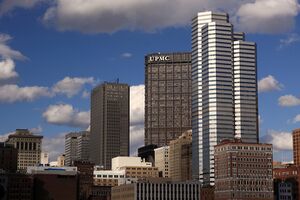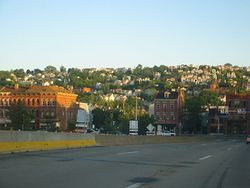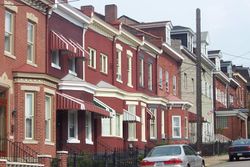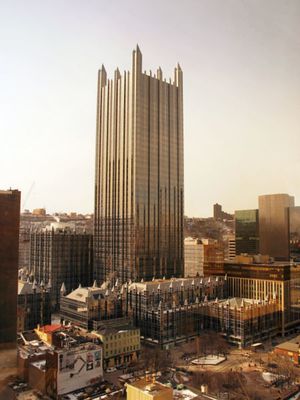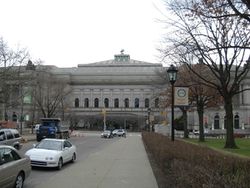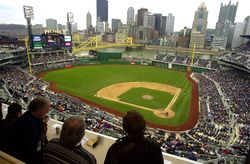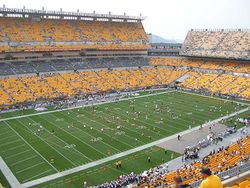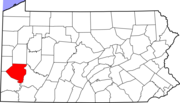پتسبرگ، پنسلڤانيا
مدينة پيتسبرگ
Pittsburgh | |||
|---|---|---|---|
City | |||
 Clockwise from top: Pittsburgh skyline; Carnegie Mellon University; PNC Park; Duquesne Incline; Cathedral of Learning at the University of Pittsburgh | |||
| الكنية: مدينة الجسور, مدينة الصلب , مدينة الحملات, المدينة, مدينة الحديد, Steel Town, مدينة الجامعة, Roboburgh | |||
| الشعار: | |||
Interactive maps of Pittsburgh | |||
| الإحداثيات: 40°26′23″N 79°58′35″W / 40.43972°N 79.97639°WCoordinates: 40°26′23″N 79°58′35″W / 40.43972°N 79.97639°W | |||
| مقاطعة | |||
| كومنويلث | |||
| مقاطعة | Allegheny | ||
| Historic empires | |||
| Historic colonies | |||
| تأسست | 27 نوفمبر 1758 | ||
| أدرجت | 22 أبريل 1794 (إقليم) | ||
| 18 مارس 1816 (مدينة) | |||
| الحكومة | |||
| • النوع | Mayor-council | ||
| • Mayor | Bill Peduto (D) | ||
| • City Council | قائمة
| ||
| المساحة | |||
| • City | 58٫34 ميل² (151٫11 كم²) | ||
| • البر | 55٫38 ميل² (143٫42 كم²) | ||
| • الماء | 2٫97 ميل² (7٫69 كم²) 4.8% | ||
| • العمران | 5٬343 ميل² (13٬840 كم²) | ||
| أعلى منسوب | 1٬370 ft (420 m) | ||
| أوطى منسوب | 710 ft (220 m) | ||
| التعداد (2010) | |||
| • City | 305٬704 | ||
| • Estimate (2019)[2] | 300٬286 | ||
| • الترتيب | US: 66th | ||
| • الكثافة | 5٬422٫67/sq mi (2٬093٫70/km2) | ||
| • Urban | 1٬775٬634 (US: 25th) | ||
| • العمرانية | 2٬362٬453 (US: 22nd) | ||
| • CSA | 2٬659٬937 (US: 24th) | ||
| • GMP | $131٫3 billion (23rd) | ||
| صفة المواطن | Pittsburgher, Yinzer | ||
| منطقة التوقيت | UTC−5 (Eastern Standard Time) | ||
| • الصيف (التوقيت الصيفي) | UTC−4 (Eastern Daylight Time) | ||
| ZIP Code | 34 total ZIP codes:
| ||
| مفتاح الهاتف | 412, 724, 878 | ||
| FIPS code | 42-61000 | ||
| GNIS feature ID | 1213644 | ||
| الموقع الإلكتروني | pittsburghpa | ||
Invalid designation | |||
| التوصيف | 1946[3] | ||
بيتسبرگ (بالإنجليزية Pittsburgh؛ /ˈpɪtsbɜːrɡ/ PITS-burg)، هي ثاني أكبر مدينة في ولاية بنسلفانيا وفي المرتبة 20 من حيث عدد السكان في الولايات المتحدة الأمريكية حيث يصل عدد السكان إلى 2.358.695 ، وفي المرتبة رقم 50 من حيث المساحة في أمريكا الشمالية. وتحتوي مدينة پيتسبرگ على 151 مبنى شاهق ,[4] ، و 446 جسر ,[5] وسط المدينة مخطط على هيئة مثلث حيث تلتقي الأنهار المارة في المدينة. وتعرف المدينة بأنها مدينة الصلب وذلك لشهرة صناعة الصلب بها.
Pittsburgh is located in the southwest of the state, at the confluence of the Allegheny River and the Monongahela River, forming the Ohio River.[6] Pittsburgh is known both as "the Steel City" for its more than 300 steel-related businesses and as the "City of Bridges" for its 446 bridges.[7] The city features 30 skyscrapers, two inclined railways, a pre-revolutionary fortification and the Point State Park at the confluence of the rivers. The city developed as a vital link of the Atlantic coast and Midwest, as the mineral-rich Allegheny Mountains made the area coveted by the French and British empires, Virginians, Whiskey Rebels, and Civil War raiders.[8]
Aside from steel, Pittsburgh has led in the manufacturing of other important materials — aluminum and glass — and in the petroleum industry. Additionally, it is a leader in computing, electronics, and the automotive industry.[9] For part of the 20th century, Pittsburgh was behind only New York City and Chicago in corporate headquarters employment; it had the most U.S. stockholders per capita.[10] Deindustrialization in the 1970s and 80s laid off area blue-collar workers as steel and other heavy industries declined, and thousands of downtown white-collar workers also lost jobs when several Pittsburgh-based companies moved out.[11] The population dropped from a peak of 675,000 in 1950 to 370,000 in 1990. However, this rich industrial history left the area with renowned museums, medical centers,[12] parks, research centers, and a diverse cultural district.[13]
After the deindustrialization of the mid-20th century, Pittsburgh has transformed into a hub for the health care, education, and technology industries.[14] Pittsburgh is a leader in the health care sector as the home to large medical providers such as University of Pittsburgh Medical Center (UPMC). The area is home to 68 colleges and universities, including research and development leaders Carnegie Mellon University and the University of Pittsburgh.[15] Google, Apple Inc., Bosch, Facebook, Uber, Nokia, Autodesk, Amazon, Microsoft and IBM are among 1,600 technology firms generating $20.7 billion in annual Pittsburgh payrolls. The area has served as the long-time federal agency headquarters for cyber defense, software engineering, robotics, energy research and the nuclear navy.[16] The nation's eighth-largest bank, eight Fortune 500 companies, and six of the top 300 U.S. law firms make their global headquarters in the area, while RAND Corporation (RAND), BNY Mellon, Nova, FedEx, Bayer, and the National Institute for Occupational Safety and Health (NIOSH) have regional bases that helped Pittsburgh become the sixth-best area for U.S. job growth.[17]
In 2015, Pittsburgh was listed among the "eleven most livable cities in the world";[18][19] The Economist's Global Liveability Ranking placed Pittsburgh as the most or second-most livable city in the United States in 2005, 2009, 2011, 2012 and 2014.[20] The region is a hub for Leadership in Energy and Environmental Design and energy extraction.[21]
. . . . . . . . . . . . . . . . . . . . . . . . . . . . . . . . . . . . . . . . . . . . . . . . . . . . . . . . . . . . . . . . . . . . . . . . . . . . . . . . . . . . . . . . . . . . . . . . . . . . . . . . . . . . . . . . . . . . . . . . . . . . . . . . . . . . . . . . . . . . . . . . . . . . . . . . . . . . . . . . . . . . . . . .
التسمية
التاريخ
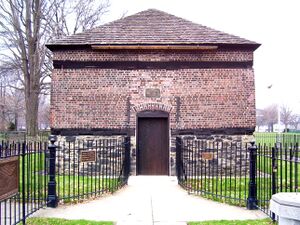
Pittsburgh was named in 1758, by General John Forbes, in honor of British statesman William Pitt, 1st Earl of Chatham. As Forbes was a Scot, he probably pronounced the name /ˈpɪtsbərə/ PITS-bər-ə (similar to Edinburgh).[22][23] Pittsburgh was incorporated as a borough on April 22, 1794, with the following Act:[24] "Be it enacted by the Pennsylvania State Senate and Pennsylvania House of Representatives of the Commonwealth of Pennsylvania ... by the authority of the same, that the said town of Pittsburgh shall be ... erected into a borough, which shall be called the borough of Pittsburgh for ever."[25] From 1891 to 1911, the city's name was federally recognized as "Pittsburg", though use of the final h was retained during this period by the city government and other local organizations.[26][22] After a public campaign, the federal decision to drop the h was reversed.[22] The Pittsburgh Press continued without the h in its nameplate until August 1, 1921.[27]
The area of the Ohio headwaters was long inhabited by the Shawnee and several other settled groups of Native Americans.[28] The first known Europeans to enter the region were the French explorers/traders Robert de La Salle and Martin Chartier from Quebec during their 1669 expedition down the Ohio River.[29] Chartier is also noted to be the first white man in Nashville, Tennessee. European pioneers, primarily Dutch, followed in the early 18th century. Michael Bezallion was the first to describe the forks of the Ohio in a 1717 manuscript, and later that year European fur traders established area posts and settlements.[30]
In 1749, French soldiers from Quebec launched an expedition to the forks to unite Canada with French Louisiana via the rivers.[30] During 1753–54, the British hastily built Fort Prince George before a larger French force drove them off. The French built Fort Duquesne based on LaSalle's 1669 claims. The French and Indian War, the North American front of the Seven Years' War, began with the future Pittsburgh as its center. British General Edward Braddock was dispatched with Major George Washington as his aide to take Fort Duquesne.[31] The British and colonial force were defeated at Braddock's Field. General John Forbes finally took the forks in 1758. He began construction on Fort Pitt, named after William Pitt the Elder while the settlement was named "Pittsborough".[32]
During Pontiac's Rebellion, native tribes conducted a siege of Fort Pitt for two months until Colonel Henry Bouquet relieved it after the Battle of Bushy Run. Fort Pitt is notable as the site of an early use of smallpox for biological warfare, whose effectiveness is questioned.[33][34][35]
During this period, the powerful nations of the Iroquois Confederacy, based in New York, had maintained control of much of the Ohio Valley as hunting grounds by right of conquest after defeating other tribes. By the terms of the 1768 Treaty of Fort Stanwix, the Penns were allowed to purchase the modern region from the Iroquois. A 1769 survey referenced the future city as the "Manor of Pittsburgh".[36] Both the Colony of Virginia and the Province of Pennsylvania claimed the region under their colonial charters until 1780, when they agreed under a federal initiative to extend the Mason–Dixon line westward, placing Pittsburgh in Pennsylvania. On March 8, 1771, Bedford County, Pennsylvania was created to govern the frontier. On April 16, 1771, the city's first civilian local government was created as Pitt Township.[37][38] William Teagarden was the first constable, and William Troop was the first clerk.[39]
Following the American Revolution, the village of Pittsburgh continued to grow. One of its earliest industries was boat building for settlers of the Ohio Country. In 1784, Thomas Viceroy completed a town plan which was approved by the Penn family attorney. Pittsburgh became a possession of Pennsylvania in 1785. The following year, the Pittsburgh Post-Gazette was started, and in 1787, the Pittsburgh Academy was chartered. Unrest during the Whiskey Rebellion of 1794 resulted in federal troops being sent to the area. By 1797, glass manufacture began, while the population grew to around 1,400. Settlers came via routes over the Appalachian Mountains or through the Great Lakes. Fort Pitt (now Pittsburgh) at the source of the Ohio River became the main base for settlers moving into the Northwest Territory.
1800 to 1900
The federal government recognizes Pittsburgh as the starting point for the Lewis and Clark Expedition.[40] Preparations began in Pittsburgh in 1803 when Meriwether Lewis purchased a keelboat that would later be used to ascend the Missouri River.[41]
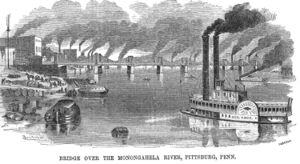
The War of 1812 cut off the supply of British goods, stimulating American industry. By 1815, Pittsburgh was producing significant quantities of iron, brass, tin, and glass. On March 18, 1816, the 46-year-old local government became a city. It was served by numerous river steamboats, that increased trading traffic on the rivers.
In the 1830s, many Welsh people from the Merthyr steelworks immigrated to the city following the aftermath of the Merthyr Rising. By the 1840s, Pittsburgh was one of the largest cities west of the Allegheny Mountains. The Great Fire of Pittsburgh destroyed over a thousand buildings in 1845. The city rebuilt with the aid of Irish immigrants who came to escape the Great Famine. By 1857, Pittsburgh's 1,000 factories were consuming 22 million coal bushels yearly. Coal mining and iron manufacturing attracted waves of European immigrants to the area, the most came from Germany.
While Pennsylvania had been established as a free state after the Revolution, enslaved African Americans sought freedom here through escape as refugees from the South, or occasionally fleeing from travelers they were serving who stayed in the city. There were active stations of the Underground Railroad in the city, and numerous refugees were documented as getting help from station agents and African-American workers in city hotels. The Drennen Slave Girl walked out of the Monongahela House in 1850, apparently to freedom.[42] The Merchant's Hotel was also a place where African-American workers would advise slaves the state was free and aid them in getting to nearby stations of the Underground Railroad.[43] Sometimes refugee slaves from the South stayed in Pittsburgh, but other times they continued North, including into Canada. Many slaves left the city and county for Canada after Congress passed the 1850 Fugitive Slave Act, as it required cooperation from law enforcement even in free states and increased penalties. From 1850 to 1860, the black population in Allegheny County dropped from 3,431 to 2,725 as people headed to more safety in Canada.[42]
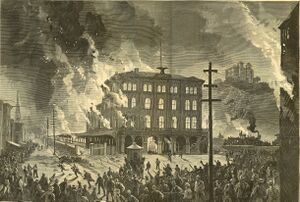
The American Civil War boosted the city's economy with increased iron and armament demand by the Union. Andrew Carnegie began steel production in 1875 at the Edgar Thomson Steel Works in North Braddock, Pennsylvania, which evolved into the Carnegie Steel Company. He adopted the Bessemer process to increase production. Manufacturing was key to growth of Pittsburgh and the surrounding region. Railroad lines were built into the city along both rivers, increasing transportation access to important markets.
1900 to present
In 1901, J. P. Morgan and attorney Elbert H. Gary merged Carnegie Steel Company and several other companies into U.S. Steel. By 1910, Pittsburgh was the nation's 8th-largest city, accounting for between one-third and one-half of national steel output.
The Pittsburgh Agreement was subscribed in May 1918 between the Czech and Slovak nationalities, as envisioned by T. G. Masaryk, concerning the future foundation of Czechoslovakia.[44]
The city's population swelled to more than a half million, attracting numerous European immigrants to its industrial jobs. By 1940, non-Hispanic whites were 90.6% of the city's population.[45] Pittsburgh also became a main destination of the African-American Great Migration from the rural South during the first half of the 20th century.[46] Limited initially by discrimination, some 95% percent of the men became unskilled steel workers.[47]
During World War II, demand for steel increased and area mills operated 24 hours a day to produce 95 million tons of steel for the war effort.[32] This resulted in the highest levels of air pollution in the city's almost century of industry. The city's reputation as the "arsenal of democracy"[48][49] was being overshadowed by James Parton's 1868 observation of Pittsburgh being "hell with the lid off."[50]
Following the war, the city launched a clean air and civic revitalization project known as the "Renaissance," cleaning up the air and the rivers. The "Renaissance II" project followed in 1977, focused on cultural and neighborhood development. The industrial base continued to expand through the 1970s, but beginning in the early 1980s both the area's steel and electronics industries imploded during national industrial restructuring. There were massive layoffs from mill and plant closures.[11]
In the later 20th century, the area shifted its economic base to education, tourism, and services, largely based on healthcare/medicine, finance, and high technology such as robotics. Although Pittsburgh successfully shifted its economy and remained viable, the city's population has never rebounded to its industrial-era highs. While 680,000 people lived in the city proper in 1950, a combination of suburbanization and economic turbulence resulted in a decrease in city population, even as the metropolitan area population increased again.
During the late 2000s recession, Pittsburgh was economically strong, adding jobs when most cities were losing them. It was one of the few cities in the United States to see housing property values rise. Between 2006 and 2011, the Pittsburgh metropolitan statistical area (MSA) experienced over 10% appreciation in housing prices—the highest appreciation of the largest 25 MSAs in the United States, as 22 of the top 25 MSAs saw a depreciation of housing values.[51] Pittsburgh's story of economic regeneration was the inspiration of President Barack Obama to host the 2009 G-20 Pittsburgh summit.[52]
. . . . . . . . . . . . . . . . . . . . . . . . . . . . . . . . . . . . . . . . . . . . . . . . . . . . . . . . . . . . . . . . . . . . . . . . . . . . . . . . . . . . . . . . . . . . . . . . . . . . . . . . . . . . . . . . . . . . . . . . . . . . . . . . . . . . . . . . . . . . . . . . . . . . . . . . . . . . . . . . . . . . . . . .
الجغرافيا
تصل مساحة مدينة پيتسبرگ إلى 58.3 ميل مربع (55.6 ميل مربع من الأرض و 2.8 ميل مربع من المياه) حيث تشكل المياه نسبة 4.75 % من إجمالي مساحة المدينة.
Cityscape
Areas
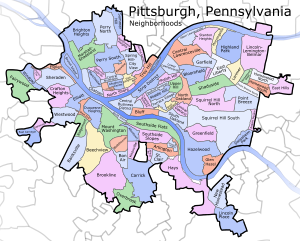
The city consists of the Downtown area, called the Golden Triangle,[53] and four main areas surrounding it. These surrounding areas are subdivided into distinct neighborhoods (Pittsburgh has 90 neighborhoods).[54] Relative to downtown, these areas are known as the Central, North Side/North Hills, South Side/South Hills, East End, and West End.
Golden Triangle
صور
المناخ
يصنف مناخ مدينة پيتسبرگ على أنه مناخ قاري رطب. وتتوافر فرصة سقوط الأمطار طوال شهور السنة الأربعة. بينما يسمح المناخ القاري بتنوعات كبيرة في درجات الحرارة ، فإن المناخ في فصل الشتاء في مدينة پيتسبرگ يكون متأثرا بالهواء القادم من بالمحيط الأطلنطي والمرتفعات المحيطة بالمدينة مما يعطي هواءا باردا في الشمال. وبصفة عامة فإن المناخ في پيتسبرگ هو مناخ بارد شتاء مع تساقط الثلوج ، و حار رطب صيفا مع بعض السحب وإمكانية سقوط الأمطار.
| درجات الحرارة الشهرية | ||||||||||||
| الشهر | يناير | فبراير | مارس | إبريل | مايو | يونيو | يوليو | أغسطس | سبتمبر | أكتوبر | نوفمبر | ديسمبر |
|---|---|---|---|---|---|---|---|---|---|---|---|---|
| Record high | 74°F (23°C) | 76° (24°) | 84° (29°) | 90° (32°) | 92° (33°) | 96° (36°) | 101° (38°) | 97° (36°) | 92° (33°) | 85° (29°) | 79° (26°) | 74° (23°) |
| Normal high | 37° (3°) | 39° (4°) | 50° (10°) | 62° (17°) | 71° (22°) | 80° (27°) | 85° (29°) | 83° (28°) | 76° (24°) | 64° (18°) | 53° (12°) | 42° (6°) |
| Normal low | 20° (-7°) | 21° (-6°) | 29° (-2°) | 38° (3°) | 48° (9°) | 56° (13°) | 62° (17°) | 60° (16°) | 53° (12°) | 41° (5°) | 33° (1°) | 25° (-4°) |
| Record low | -19° (-28°) | -2° (-19°) | 2° (-17°) | 21° (-6°) | 29° (-2°) | 38° (3°) | 37° (3°) | 47° (8°) | 35° (2°) | 22° (-6°) | 13° (-11°) | 2° (-17°) |
| Precipitation | 2.6 in. (6.6 cm.) | 2.5 (6.3) | 3.2 (8.2) | 3.1 (7.8) | 4 (10.3) | 3.9 (10) | 3.9 (9.9) | 3.2 (8) | 3.1 (8) | 2.4 (6) | 3.1 (7.7) | 2.9 (7.3) |
| Source: The Weather Channel[55] | ||||||||||||
. . . . . . . . . . . . . . . . . . . . . . . . . . . . . . . . . . . . . . . . . . . . . . . . . . . . . . . . . . . . . . . . . . . . . . . . . . . . . . . . . . . . . . . . . . . . . . . . . . . . . . . . . . . . . . . . . . . . . . . . . . . . . . . . . . . . . . . . . . . . . . . . . . . . . . . . . . . . . . . . . . . . . . . .
المنظر العام للمدينة
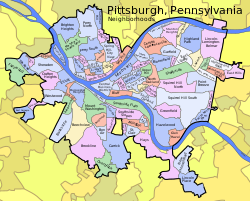 Pittsburgh is home to 89 حي سكني متميز. |
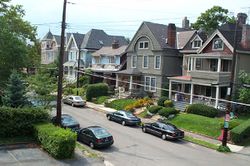 شارع في حي Shadyside في إيست إند |
السكان
| التعداد تاريخياً | |||
|---|---|---|---|
| الإحصاء | التعداد | %± | |
| 1810 | 4٬768 | ||
| 1820 | 7٬248 | 52.0% | |
| 1830 | 12٬568 | 73.4% | |
| 1840 | 21٬115 | 68.0% | |
| 1850 | 46٬601 | 120.7% | |
| 1860 | 49٬221 | 5.6% | |
| 1870 | 86٬076 | 74.9% | |
| 1880 | 156٬389 | 81.7% | |
| 1890 | 238٬617 | 52.6% | |
| 1900 | 321٬616 | 34.8% | |
| 1910 | 533٬905 | 66.0% | |
| 1920 | 588٬343 | 10.2% | |
| 1930 | 669٬817 | 13.8% | |
| 1940 | 671٬659 | 0.3% | |
| 1950 | 676٬806 | 0.8% | |
| 1960 | 604٬332 | -10.7% | |
| 1970 | 520٬117 | -13.9% | |
| 1980 | 423٬938 | -18.5% | |
| 1990 | 369٬879 | -12.8% | |
| 2000 | 334٬563 | -9.5% | |
تبعا لتقرير المكتب الأمريكي للتعداد وصل عدد الأسر في پيتسبرگ إلى 74.169 عائلة. ووصل عدد السكان 163.739. يشكل البيض نسبة 84.33% من إجمالي سكان المدينة ، بينما أخذ السود نسبة 12.41%.
الجريمة
الإقتصاد
تشكل صناعة الصلب الحجر الأساسي في الذي يقوم على أساسه إقتصاد مدينة پيتسبرگ. The growth of Pittsburgh and its economy was caused by the extensive trade of steel. Since, Pittsburgh has adapted to the collapse of the region's steel industry. The primary industries have shifted more to high technology, such as robotics, health care, nuclear engineering, tourism, biomedical technology, finance, and services. Education is also a major employer, from primary through magnet schools, specialized professional institutes and highly-ranked universities. In fact, Pittsburgh still maintains its status as a corporate headquarters city, with seven Fortune 500 companies calling the city home. This ranks Pittsburgh in a tie for the sixth-most Fortune 500 headquarters in the nation.[56] In 2006, Expansion Magazine ranked Pittsburgh among the top 10 metropolitan areas in the nation for climates favorable to business expansion.[57]
الوظائف الهامة
خلال السنوات الأخيرة تقدمت الصناعة في پيتسبرگ بما فيها الصناعات التكنولوجية ، وصناعة الأدوية. أكبر الوظائف في المدينة في جامعة پيتسبرگ الطبية (26.000 موظف) ، وفي جامعة پيتسبرگ (10.700 موظف).[58]
|
Fortune 500 Corporations:
|
Fortune 1000 Corporations:
|
الثقافة
الكتابة
اللهجة المحلية
المزارات
أهم المزارات:
|
|
المعيشة
الإعلام والثقافة العامة
الرياضة
الحكومة والسياسة
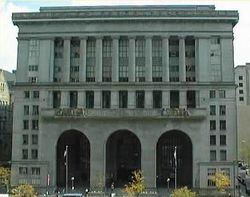
التعليم
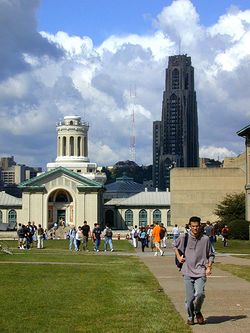
البنية التحتية
النقل
المطارات
هيئة الميناء
مدن شقيقة
ترتبط مدينة پيتسبرگ مع 16 مدينة شقيقة:[60]
|
انظر أيضا
- اليجاني , بنسلفانيا
- مدن في مقاطعة اليجاني
- Jewish history in Pittsburgh
- List of cities and towns along the Ohio River
- List of famous people from Pittsburgh
- List of fiction set in Pittsburgh
- List of hospitals in Pittsburgh
- List of people from Pittsburgh
- Pittsburgh Council for International Visitors
- Pittsburgh Coalfield
وصلات خارجية
![]() تعريفات قاموسية في ويكاموس
تعريفات قاموسية في ويكاموس
![]() كتب من معرفة الكتب
كتب من معرفة الكتب
![]() اقتباسات من معرفة الاقتباس
اقتباسات من معرفة الاقتباس
![]() نصوص مصدرية من معرفة المصادر
نصوص مصدرية من معرفة المصادر
![]() صور و ملفات صوتية من كومونز
صور و ملفات صوتية من كومونز
![]() أخبار من معرفة الأخبار.
أخبار من معرفة الأخبار.
المواقع الرسمية
هيئات
- Pittsburgh Council for International Visitors
- Pittsburgh Convention and Visitors Bureau - Tourism
- Pittsburgh History & Landmarks Foundation
- Pittsburgh's Intergovernmental Cooperation Authority
- Young Preservationists Association of Pittsburgh
السفر
- Pittsburgh travel guide from Wikitravel
- Guide to find your way around Pittsburgh, Pennsylvania
- About Pittsburgh - Guide to Pittsburgh & Western PA
خرائط وصور
إهتمامات خاصة
- Bridges of Pittsburgh and Allegheny County
- Pittsburgh Independent Media Center
- German Heritage Sites in Pittsburgh
- Pittsburgh Pharaoh Hounds running team
- Pittsburgh arts festival
- Gallery Crawl
مقالات عامة أخرى
- The Geological History of Pittsburgh
- Pittsburgh History to 1800 - at Citizendium
- Pittsburgh History since 1800 - at Citizendium
المصادر
- ^ "2019 U.S. Gazetteer Files". United States Census Bureau. Retrieved July 28, 2020.
- ^ خطأ استشهاد: وسم
<ref>غير صحيح؛ لا نص تم توفيره للمراجع المسماةUSCensusEst2019 - ^ "Approved Markers". Pennsylvania Historical and Museum Commission. Commonwealth of Pennsylvania. Retrieved December 26, 2018.
- ^ "High-rise Buildings of Pittsburgh"
- ^ Pitt Chronicle: "Venice, Schmenice"
- ^ "Pittsburgh". Encyclopaedia Britannica.
- ^ قالب:Pittsburgh Names
- ^ قالب:Pittsburgh history
- ^ قالب:Pittsburgh Industries
- ^ قالب:Pittsburgh financial
- ^ أ ب قالب:Pittsburgh diaspora
- ^ قالب:Pittsburgh medical
- ^ خطأ استشهاد: وسم
<ref>غير صحيح؛ لا نص تم توفيره للمراجع المسماةRitenbaugh - ^ 30 Years: Pittsburgh moves from heavy industry to medicine, tech, energy
- ^ قالب:Pittsburgh colleges
- ^ قالب:Pittsburgh Technology. The University of Pittsburgh is amongst the top 20 universities in the country by the amount of federal research funding granted by the NIH, and CMU is amongst the top 50 universities in the country by amount of federal research funding granted by the NSF.
- ^ قالب:Pittsburgh economics
- ^ "The Metropolis Guide to the Best Cities to Live, Work, and Play in (2015)". Metropolis. July 28, 2015. Retrieved May 18, 2019.
- ^ "Pittsburgh Named One of the Most Livable Cities in the World". KDKA-TV. July 31, 2015. Retrieved May 18, 2019.
- ^ "A Summary of the Liveability Ranking and Overview—August 2014". The Economist. August 25, 2014. Retrieved May 18, 2019.
- ^ خطأ استشهاد: وسم
<ref>غير صحيح؛ لا نص تم توفيره للمراجع المسماةGrEn - ^ أ ب ت "How to Spell Pittsburgh". Carnegie Library of Pittsburgh. Archived from the original on أكتوبر 1, 2008. Retrieved سبتمبر 22, 2006.
- ^ Conradt, Stacy (October 1, 2013). "How Pittsburgh Got Its "H" Back". Mental Floss. Retrieved May 18, 2019.
- ^ "Pittsburgh Facts". Pittsburgh Post-Gazette. January 1, 2003. Retrieved October 21, 2007.
- ^ "An ACT to erect the town of Pittsburgh ..." Carnegie Library of Pittsburgh. Archived from the original on يوليو 6, 2007. Retrieved سبتمبر 22, 2006.
- ^ Stewart, George R. (1967) [1945]. Names on the Land: A Historical Account of Place-Naming in the United States (Sentry edition (3rd) ed.). Houghton Mifflin. pp. 342–344.
- ^ "THE PITTSBURGH PRESS". 1921-08-21. p. 1.
- ^ Solon J. Buck, Elizabeth Buck, The Planting of Civilization in Western Pennsylvania, 1976, Google Boeken. Books.google.com. Retrieved on July 17, 2013.
- ^ "friendsoftheriverfront.org". Friendsoftheriverfront.org. Archived from the original on January 11, 2008. Retrieved January 5, 2009.
- ^ أ ب "Historic Pittsburgh: Chronology". University of Pittsburgh Library System. Retrieved December 26, 2017.
- ^ "The Battle of the Monongahela". World Digital Library. 1755. Retrieved August 3, 2013.
- ^ أ ب Lorant, Stefan (1999). Pittsburgh, The Story of an American City (5th ed.). Esselmont Books, LLC. ISBN 978-0-685-92012-1.
- ^ White, Phillip M. (June 2, 2011). American Indian Chronology: Chronologies of the American Mosaic. Greenwood Publishing Group. p. 44.
- ^ Ranlet, Phillip (2000). The British, the Indians, and smallpox: what actually happened at Fort Pitt in 1763? Pennsylvania history; 67(3).
- ^ Dixon, David (2005). Never Come to Peace Again: Pontiac's Uprising and the Fate of the British Empire in North America. University of Oklahoma Press.
- ^ Chamber of Commerce of Pittsburgh (1921). Pittsburgh First, the Official Organ of The Chamber of Commerce of Pittsburgh.
- ^ Full text of "The county court for the district of West Augusta, Virginia, held at Augusta town, near Washington, Pennsylvania, 1776–1777". Archive.org. Retrieved on July 17, 2013.
- ^ "A brief history of Greene County and its courts: a struggle for possession" (PDF).
- ^ Christopher, Joan (December 9, 2005). "Constables for 1771". Pa-roots.org. Archived from the original on August 22, 2016. Retrieved May 24, 2016.
- ^ Bauder, Bob (March 10, 2019). "Pittsburgh recognized as starting point for Lewis and Clark expedition". Pittsburgh Tribune Review.
- ^ O'NEILL, BRIAN (May 13, 2018). "Lewis & Clark started here (sorry, St. Louis)". Pittsburgh Post-Gazette.
- ^ أ ب William J. Switala, Underground Railroad in Pennsylvania, Stackpole Books, 2001, pp. 88-89
- ^ Exhibit: Free at Last? Slavery in Pittsburgh in the 18th and 19th Centuries, 2009, University of Pittsburgh Library
- ^ PRECLÍK, Vratislav. Masaryk a legie (Masaryk and legions), váz. kniha, 219 str., vydalo nakladatelství Paris Karviná, Žižkova 2379 (734 01 Karviná) ve spolupráci s Masarykovým demokratickým hnutím (Masaryk democratic movement, Prague), 2019, ISBN 978-80-87173-47-3,s. 8 - 48, s. 84 - 124, s. 125 - 148, s. 157, s. 164 - 169, s. 170 - 194
- ^ "Race and Hispanic Origin for Selected Cities and Other Places: Earliest Census to 1990". U.S. Census Bureau. Archived from the original on August 12, 2012. Retrieved January 3, 2012.
- ^ Boucher, Amber (February 18, 2003). "Kids' Corner: 1910-30 saw huge black migration". Pittsburgh Post-Gazette. Retrieved May 18, 2019.
- ^ Lubove, Roy, ed. Pittsburgh. New York: New Viewpoints, 1976. Print.
- ^ "The Pittsburgh Press – Google News Archive Search". Retrieved June 11, 2015.
- ^ "The Way We Were". Retrieved June 11, 2015.
- ^ Kalson, Sally (November 19, 2003). "Cartoonist draws, fires a blank with Pittsburgh joke". Pittsburgh Post-Gazette.
- ^ Briem, Christopher (December 30, 2011). "More Pittsburgh real estate trends". Nullspace. Retrieved January 1, 2012.
- ^ "US to host next G20 world meeting". BBC News. May 28, 2009. Retrieved May 22, 2010.
- ^ "Golden Triangle (Pittsburgh)". Emporis.com. Retrieved April 11, 2009.
- ^ "Pittsburgh Neighborhoods". City of Pittsburgh Portal. Archived from the original on June 29, 2007. Retrieved July 17, 2007.
- ^ Seasonal Temperature and Precipitation Information from The Weather Channel. Retrieved on 26 يناير, 2008.
- ^ "Fortune 500: Cities with Five or More Fortune 500 Headquarters". Fortune. April 2007.
- ^ "2006 MAYOR'S CHALLENGE: Where Are the Best Metros for Future Business Locations?". Expansion Magazine. August 7, 2006.
{{cite news}}: Check date values in:|date=(help) - ^ "Top Private Employers". Pittsburgh Regional Alliance. Retrieved 14 April.
{{cite web}}: Check date values in:|accessdate=(help); Unknown parameter|accessyear=ignored (|access-date=suggested) (help) - ^ Kadushin, Raphael (2003). "15222: Come Hungry". National Geographic: pp. 114–122. Retrieved 2007-08-26.
{{cite journal}}:|pages=has extra text (help); Unknown parameter|month=ignored (help) - ^ "Sister Cities Online Directory: Pennsylvania, USA." Sister Cities International, Inc. (SCI). Retrieved on 26 يناير, 2008.
- CS1: Julian–Gregorian uncertainty
- CS1 errors: unsupported parameter
- CS1 errors: extra text: pages
- Short description is different from Wikidata
- Articles with hatnote templates targeting a nonexistent page
- Pages using infobox settlement with possible nickname list
- Coordinates on Wikidata
- صفحات تستخدم جدول مستوطنة بقائمة محتملة لصفات المواطن
- پتسبرگ
- مقاطعة ألگـِني، پنسلڤانيا
- منطقة پتسبرگ العمرانية
- مدن في بنسلفانيا
- مدن على نهر أوهايو
- مدن أسست في 1758
- تأسيسات 1794
- County seats in Pennsylvania
- Towns and cities with limited zero-fare transport
- Port cities in the United States
- صفحات مع الخرائط





